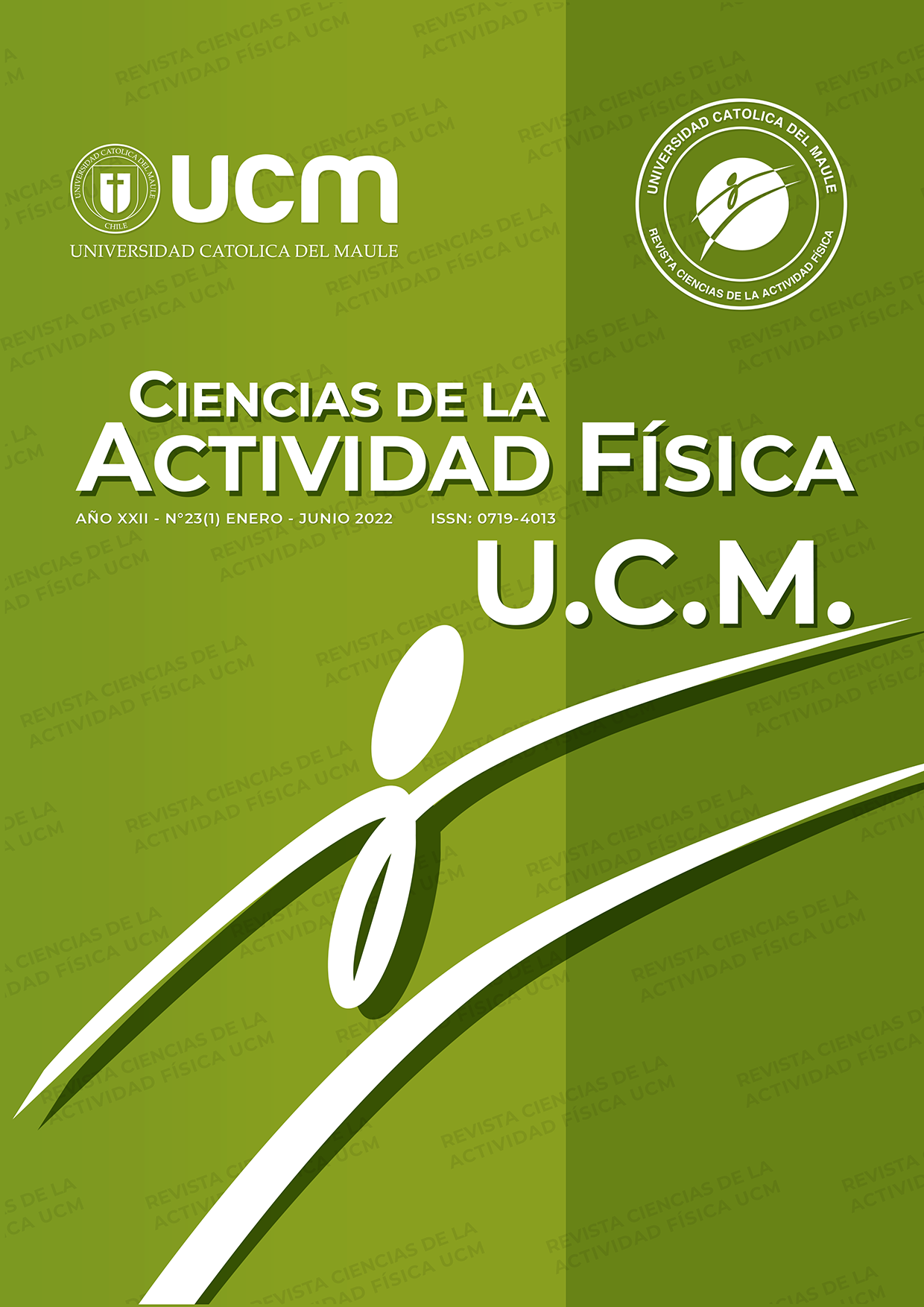Potencia muscular en relación a la composición corporal en jugadores de voleibol adolescentes según género
Contenido principal del artículo
Resumen
Detalles del artículo
Abidin, N. Z., & Adam, M. B. (2013). Prediction of vertical jump height from anthropometric factors in male and female martial arts athletes. The Malaysian Journal of Medical Sciences, 20(1), 39-45. https://www.ncbi.nlm.nih.gov/pmc/articles/PMC3684376/
Acar, H., & Eler, N. (2019). The Relationship between Body Composition and Jumping Performance of Volleyball Players. Journal of Education and Training Studies, 7(3), 192-196. https://doi.org/10.11114/jets.v7i3.4047
Brechue, W. F., & Abe, T. (2002). The role of FFM accumulation and skeletal muscle architecture in powerlifting performance. European journal of applied physiology, 86(4), 327–336. https://doi.org/10.1007/s00421-001-0543-7
Ćopić, N., Dopsaj, M., Ivanović, J., Nešić, G., & Jarić, S. (2014). Body composition and muscle strength predictors of jumping performance: differences between elite female volleyball competitors and nontrained individuals. Journal of Strength and Conditioning Research, 28(10), 2709–2716. https://doi.org/10.1519/JSC.0000000000000468
Cosmin, S. C., Mihaela, R. A., & Claudiu, A. (2016). Anthropometric Characteristics, Body Composition and Physical Performance of Female Cadet Volleyball Players. Journal of Physical Education and Sport, 16, 664-667. https://efsupit.ro/images/stories/nr1.2016/Art%20106.pdf
Dopsaj, M. M., Copic, N., Nesic, G., & Sikimic, M. (2012). Jumping performance in elite female volleyball players relative to playing positions: A practical multidimensional assesment model. Serbian Journal of Sports Sciences, 6(2): 61-69. https://web.s.ebscohost.com/abstract?direct=true&profile=ehost&scope=site&authtype=crawler&jrnl=18206301&AN=77418966&h=
AiLFYMAwgldc80xtgak87grF3elFQ4MS4m0O3fbsQgqSSfyY3A%2fhhwTkWEZuJqAVm5ZWVZXWvPoVABqsKBE
%2ftw%3d%3d&crl=c&resultNs=AdminWebAuth&resultLocal=ErrCrlNotAuth&crlhashurl=
login.aspx%3fdirect%3dtrue%26profile%3dehost%26scope%3dsite%26authtype%3dcrawler
%26jrnl%3d18206301%26AN%3d77418966
García-Hermoso, A., Dávila-Romero, C., & Saavedra, J. M. (2013). Discriminatory power of game-related statistics in 14-15 year age group male volleyball, according to set. Perceptual and Motor Skills, 116(1), 132–143. https://doi.org/10.2466/03.30.PMS.116.1.132-143
Graham, S. R., Cormack, S., Parfitt, G., & Eston, R. (2018). Relationships Between Model Estimates and Actual Match-Performance Indices in Professional Australian Footballers During an In-Season Macrocycle. International Journal of Sports Physiology and Performance, 13(3), 339–346. https://doi.org/10.1123/ijspp.2017-0026
Hank, M., Zahalka, F., & Maly, T. (2015). Comparison of spikers' distance covered in elite female volleyball. Sport Science, 8(Suppl. 2), 102‐106. https://www.sposci.com/PDFS/BR08S2/SVEE/04%20CL%2017%20MH.pdf
Hegge, A. M., Myhre, K., Welde, B., Holmberg, H. C., & Sandbakk, Ø. (2015). Are gender differences in upper-body power generated by elite cross-country skiers augmented by increasing the intensity of exercise? PLoS ONE, 10(5), e0127509. https://doi.org/10.1371/journal.pone.0127509
Janssen, I., Heymsfield, S. B., Wang, Z. M., & Ross, R. (2000). Skeletal muscle mass and distribution in 468 men and women aged 18-88 yr. Journal of Applied Physiology, 89(1), 81-88. https://doi.org/10.1152/jappl.2000.89.1.81
Lindle, R. S., Metter, E. J., Lynch, N. A., Fleg, J. L., Fozard, J. L., Tobin, J., Roy, T. A., & Hurley, B. F. (1997). Age and gender comparisons of muscle strength in 654 women and men aged 20-93 yr. Journal of Applied Physiology, 83(5), 1581–1587. https://doi.org/10.1152/jappl.1997.83.5.1581
Marfell-Jones, M., Olds, T., Stewart, A., & Carter, L. (2006). International standards for anthropometric assessment. Potchefstroom.
Mascherini, G., Castizo-Olier, J., Irurtia, A., Petri, C., & Galanti, G. (2018). Differences between the sexes in athletes' body composition and lower limb bioimpedance values. Muscles, Ligaments and Tendons Journal, 7(4), 573–581. https://doi.org/10.11138/mltj/2017.7.4.573
Miller, A. E., MacDougall, J. D., Tarnopolsky, M. A., & Sale, D. G. (1993). Gender differences in strength and muscle fiber characteristics. European Journal of Applied Physiology and Occupational Physiology, 66(3), 254–262. https://doi.org/10.1007/BF00235103
Nikolaidis, P. T., Asadi, A., Santos, E. J., Calleja-González, J., Padulo, J., Chtourou, H., & Zemkova, E. (2015). Relationship of body mass status with running and jumping performances in young basketball players. Muscles, Ligaments and Tendons Journal, 5(3), 187–194. https://doi.org/10.11138/mltj/2015.5.3.187
Palao, J. M., Manzanares, P., & Valadés, D. (2014). Anthropometric, physical, and age differences by the player position and the performance level in volleyball. Journal of Human Kinetics, 44(1), 223-236. https://doi.org/10.2478/hukin-2014-0128
Pérez-López, A., Chena Sinovas, M., Alvarez-Valverde, I., & Valades, D. (2015). Relationship between body composition and vertical jump performance in young spanish soccer players. Journal of Sport and Human Performance, 3(3). https://journals.tdl.org/jhp/index.php/JHP/article/view/63
Prado, C. M., Lieffers, J. R., McCargar, L. J., Reiman, T., Sawyer, M. B., Martin, L., & Baracos, B. E. (2008). Prevalence and clinical implications of sarcopenic obesity in patients with solid tumours of the respiratory and gastrointestinal tracts: a population-based study. The Lancet. Oncology, 9(7), 629–635. https://doi.org/10.1016/S1470-2045(08)70153-0
Ramírez-Campillo, R., Andrade, D. C., & Izquierdo, M. (2013). Effects of plyometric training volume and training surface on explosive strength. Journal of Strength and Conditioning Research, 27(10), 2714–2722. https://doi.org/10.1519/JSC.0b013e318280c9e9
Roberts, B. M., Nuckols, G., & Krieger, J. W. (2020). Sex Differences in Resistance Training: A Systematic Review and Meta-Analysis. Journal of Strength and Conditioning Research, 34(5), 1448–1460. https://doi.org/10.1519/JSC.0000000000003521
Tallis, J., Hill, C., James, R. S., Cox, V. M., & Seebacher, F. (2017). The effect of obesity on the contractile performance of isolated mouse soleus, EDL, and diaphragm muscles. Journal of Applied Physiology, 122(1), 170–181. https://doi.org/10.1152/japplphysiol.00836.2016
Valladares, N., García-Tormo, J. V., & Joao, P. (2016). Analysis of variables affecting performance in senior female volleyball world championship 2014. International Journal of Performance Analysis in Sport, 16(1), 401-410. https://doi.org/10.1080/24748668.2016.11868895
Ye, X., Loenneke, J. P., Fahs, C. A., Rossow, L. M., Thiebaud, R. S., Kim, D., Bemben, M.G., & Abe, T. (2013). Relationship between lifting performance and skeletal muscle mass in elite powerlifters. The Journal of Sports Medicine and Physical Fitness, 53(4), 409-414. https://pubmed.ncbi.nlm.nih.gov/23828289/
Zagatto, A. M., Milioni, F., Freitas, I. F., Arcangelo, S. A., & Padulo, J. (2016). Body composition of table tennis players: comparison between performance level and gender. Sport Sciences for Health, 12, 49–54. https://doi.org/10.1007/s11332-015-0252-y

Esta obra está bajo una licencia de Creative Commons Reconocimiento-NoComercial-CompartirIgual 4.0 Internacional

